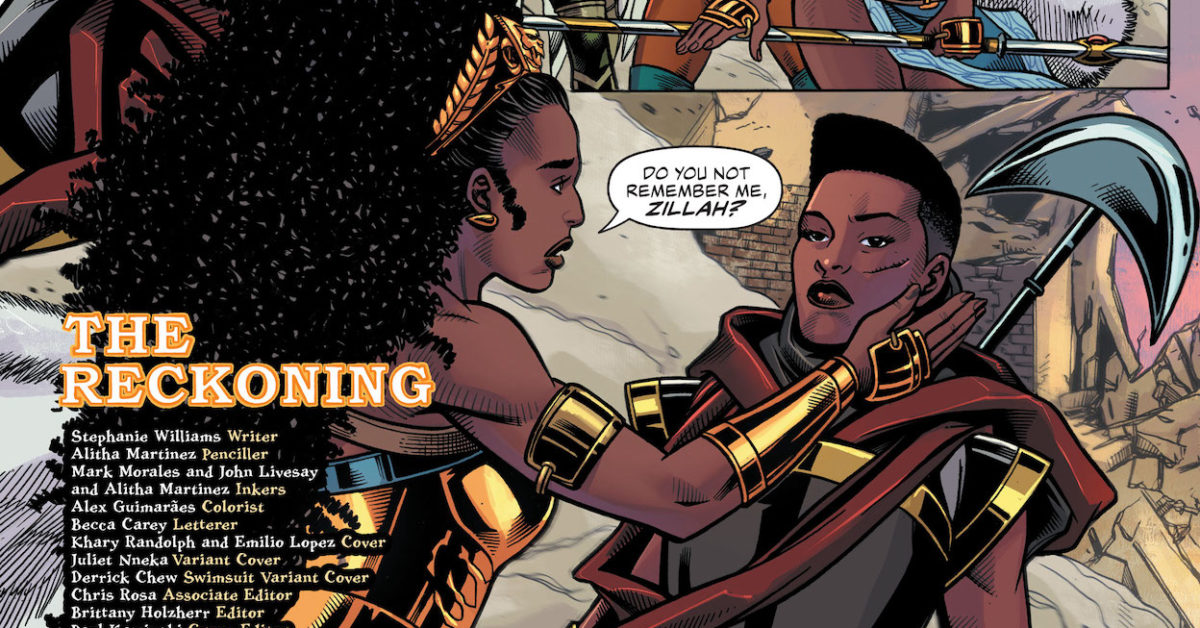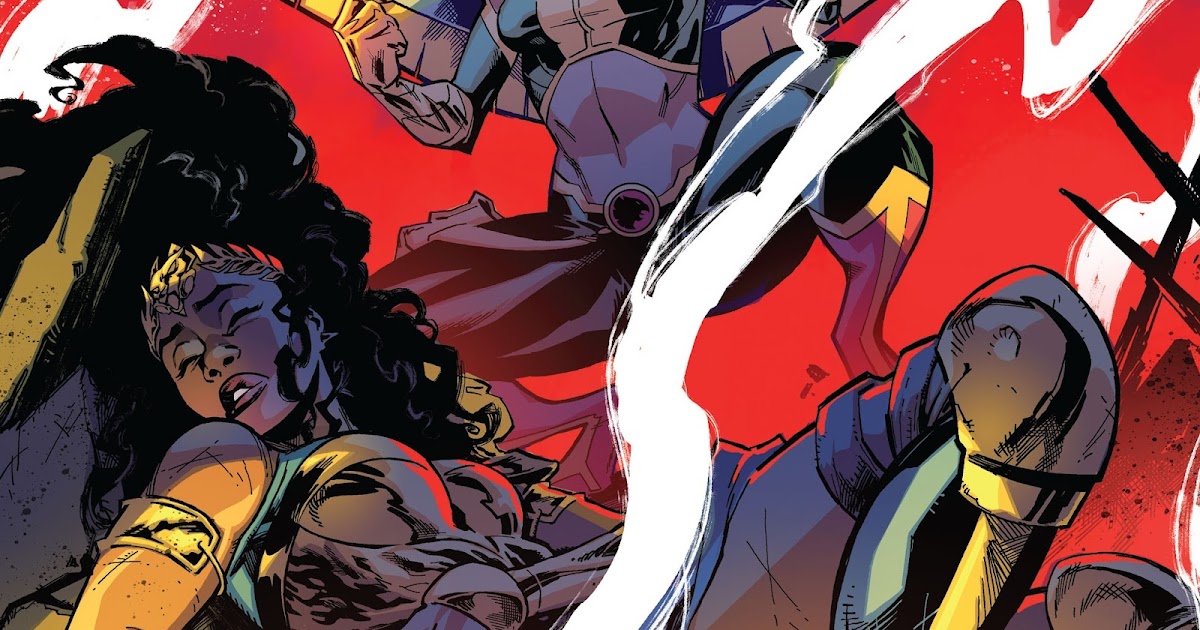Review: Nubia: Queen of the Amazons

[Editor’s Note: This review may contain spoilers]
Writers: Stephanie Williams
Penciller: Alitha Martinez
Inker: Mark Morales, John Livesay, Alitha Martinez
Colorist: Alex Guimaraes
Letterer: Becca Carey
Reviewed by: Kelly Gaines
The world is expanding for the Amazons of Themyscira. In recent years more than ever before, what was once a small community of Greek mythology-inspired warriors under the supervision of their respective pantheon has widened to include new Amazonian sisters from around the world. This gives DC an opportunity to cleanly incorporate a variety of mythic traditions and cultures into the lore of Themyscira.
Writers playing in the proverbial Amazonian sandbox have a limitless selection of gods, goddesses, monsters, and shiny McGuffins to bring into the fold, and Nubia: Queen of the Amazons certainly doesn’t disappoint in the realm of mythic crossovers. Nubia’s backstory has been vague up to this point, establishing her as a mystery, both to the reader and herself. As promised, Stephanie William’s Nubia: Queen of the Amazons brings pieces of the new queen’s past out of the shadows. As it turns out, Nubia was always destined for leadership, though her destiny is certainly not as straightforward as it seemed.
This title picks up with Nubia and a handpicked team of her fellow Amazons as they depart for the “world of men” in style. Rolls Royce? Nope, they’ve got a flying island! The Justice League is thrilled to have an opportunity to deepen its bond with Hippolyta’s successor, but not everyone agrees that the appearance of the Amazons is a good thing. Some ordinary citizens fear that the arrival of Nubia and her crew will only attract trouble (nodding to the thousands in collateral damage often caused by super show-downs) and, to be frank, they’re not wrong.
Nubia’s very first press conference in Brazil triggers a potentially deadly attack, complicating the already fraught relationship between her Amazons and the citizens that would prefer less of a super-powered presence in the world.

While her friends address a genuine PR crisis and scramble to protect their queen, Nubia struggles to piece together her past with a new sense of urgency. After a second attack, Nubia realizes that she recognizes her attacker, though the memories are hazy. Ominously, her attacker recognizes her too – not just as Nubia, but as Princess Zahavah.
In a life long forgotten, Nubia (then known as Princess Zahavah) was the daughter of a king and assumed heir to the throne. Despite her royal responsibilities, she felt her true calling in life lay not on the throne, but on the battlefield. A respected and skillful warrior, Zahavah earned the favor of the goddess Sekhmet and was offered the chance to become Sekhmet’s avatar on earth.
Ignoring her father’s protests, Nubia accepted the goddess’s challenge and completed her trials successfully. She became a hero to her people, most notably a young girl name Zillah. Sadly, Zahavah was taken from her people in battle, though Zillah (rightly) suspected foul play.

Battling with the mysterious stranger, Nubia discovers her foe is the young girl she remembers, but Zillah has changed in the centuries since they last met. Sorrow and grief over the death of her hero drove her to a path of vengeance, eventually connecting Zillah to Sekhmet herself.
By the time we meet Zillah, she is on a warpath to become Sekhmet’s new avatar, and she intends to take Nubia’s amulet at any cost. Unfortunately, Zillah has a romanticized idea of Sekhmet in her head. She assumes that with the goddess’s favor she is protected from harm and guaranteed the incredible power Sekhmet once offered Nubia. She is unaware of the life-threatening tests Zahavah overcame to gain Sekhmet’s power. Her benevolent patron goddess is far from kind and empathetic, and Zillah is playing with forces far beyond her understanding.

There’s a good reason why Sekhmet displays such duality and fluctuating loyalty to her intended human avatar. In Egyptian mythology, Sekhmet is the goddess of war, plague, chaos, the hot desert sun, and (surprisingly) healing. In versions of Egyptian mythology, Sekhmet was an incarnation of the fertility goddess Hathor, and only assumed her more violent form when angered. Her name directly translates to “she who is powerful,” but she has a number of other epitaphs including “Bloodthirsty,” “The Destroyer,” and “The Mistress of Dread.” In fact, in a statue at Mut Temple in Karnak, she is referred to as “Smiter of Nubians.” Coincidence? Probably.
In any case, Sekhmet is a goddess of violence, rage, and power. Ancient Egyptians invoked Sekhmet’s name in battle, flying her image on their banners to project a message of the Pharaoh’s might. Off the battlefield, offerings were made to appease her legendary anger. Earning her favor was a great, necessary, and arguably terrible, honor. And of course, that favor could change with the wind.

Only during Nubia’s initial reunion with Zillah do we find out that Sekhmet’s favor had more to do with proving a point to Nubia’s father than it did with receiving the blessing of a goddess. Even Nubia’s perception of her patron was skewed from the start. The comic does an excellent job of depicting humanity’s tenuous relationship with Sekhmet. She may be divine, but she’s not trustworthy. She may offer help, but always at a cost, and only until her personal desires change.
Zillah’s eventual demise is a perfect example of Sekhmet’s ambivalence (if not out-and-out cruelty) to humanity. Zillah believes that she is Sekhmet’s new avatar, her chosen representative on Earth. With the goddess’ protection, she assumes that victory over Nubia is guaranteed, yet in the decisive moment of battle, Sekhmet abandons Zillah and leaves her to her fate.

I have a reason for including all of this background information on Sekhmet. Understanding how this goddess interacts with humanity gives us a pretty strong hint of what lies ahead for Nubia and her friends. At the end of Issue #4, we witness a meeting between Sekhmet and Hera, which concludes with a mutual agreement to reign chaos down on mortals and the Amazons, who the goddesses agree are getting a little too big for their britches. If mythological records of Sekhmet are any indication, this is BAD news for Nubia, The Justice League, The Amazons, and anyone else circling this mortal coil.
If you’re at all familiar with Greek mythology, Hera is a goddess that requires no introduction. Similar to the Hathor/ Sekhmet paradigm, she’s a symbol of motherhood and family with a hair-trigger temper and murderous tendencies. Simply put, the key things these goddesses could chat about over a bottle of wine (or blood, by Sekhmet’s preference) are violence and vengeance. Their team-up suggests a terrible storm on the horizon for Nubia and her Amazonian sisters.
Nubia: Queen of the Amazons deepens the lore of the DC universe and clears up some of the mystery surrounding the Amazon’s new queen. Though I wouldn’t call it the most exciting title I’ve read of late, it sets up Nubia’s future adventures in a complex, mythologically clever way. It’s a worthwhile read for any fans currently enjoying the extended Amazon mythos, and anyone who enjoys an action-packed book.
I’m looking forward to seeing what trouble Sekhmet and Hera stir up for the queen, and I would bet whatever my bottom dollar is that we’ll be seeing more of Wonder Girl, Hawkgirl, and Wonder Woman along the way. The story is set to continue in the pages of Wonder Woman, and if that means we get to see an all-out goddess battle, I’m all for it.

**All issues of Nubia: Queen of the Amazons are currently available, and the collected edition, which will include tales from Nubia & the Amazons #1, Nubia: Coronation Special #1, and Nubia: Queen of the Amazons #1-4, will be hitting shelves this December.